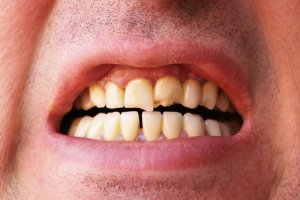Does flashing a big smile make you feel self-conscious? Composite veneers may help you boost your confidence and give you the perfect smile you’ve always longed for.
Treating tooth stains that are caused by tobacco, coffee, wine, or cola-based drinks can often be challenging, especially with at-home treatments. These acidic foods can wear down tooth enamel. And once enamel is damaged, it doesn’t grow back, which can lead to various oral health issues, like chipping.
Dental veneers present an all-around solution to these types of problems. Whether you have discolored, chipped, or crooked teeth, a composite resin veneer can hide them all, and the process is simple. Before you get veneers, however, let’s take a look at exactly what composite veneers are and if they’re right for you.
What are composite veneers?
Composite veneers are thin shells designed to cover imperfections in the shape, size, or color of your teeth. These aesthetic restorations are made from a special composite resin material.
Composite resin is commonly used for various other dental procedures, like fillings and dental bonding. This tooth-colored resin produces lifelike results that restore your smile. Also, because they’re minimally invasive, you typically doesn’t feel much discomfort during or after the procedure.
Reasons you might need dental veneers include:
- Permanent stains in teeth associated to tetracycline, fluorosis, and amelogenesis
- Fractured and worn teeth
- Abnormal tooth shape
- Minor tooth malocclusion
- Intra-oral repair of fractured crown and bridge facings
Limitations for dental veneers include:
- lrregular habits such as bruxism
- Abnormal contact between upper and lower teeth
- Deficient oral hygiene
- Scarce enamel structure
Composite veneers vs. porcelain veneers
Composite resin isn’t the only veneer material out there. Porcelain is another popular, though more expensive, veneer option. Both composite and porcelain veneers are great at improving your smile, but depending on your budget, purpose, and the extent of enamel damage, your dentist may prefer one over the other. Let’s compare them.


dentists suggest dental veneers.
Time
Composite veneers are quicker to craft and apply than porcelain veneers. They’re often referred to as “same day veneers” because they can be fitted in a single visit. The process is less complicated and conserves more of the original tooth structure.
Your dentist will match the resin to the shade of your surrounding teeth for a natural, blended look. The veneer is bonded to your tooth and polished and you’re good to go.
Fitting porcelain veneers, on the other hand, typically takes at least two visits to the dentist’s office. Porcelain veneers need to be constructed outside the office in a dental lab and the procedure is a little more invasive on the tooth structure. You may need to wear temporary veneers while waiting for your real veneers. Your customized porcelain veneers can be bonded to your teeth at the second visit.
Durability
Many studies estimate that veneers will retain 80–89% or the original after 5 years if you care for them properly. This is one area where porcelain veneers outshine composite because porcelain has a survival rate of 94.4% after five years, 93.5% after ten years and 91% after 20 years. Porcelain veneers, once bonded to teeth, are extremely durable, whereas composite veneers are more prone to chipping over time. Getting composite veneers repaired is pretty straightforward, but in the case of porcelain veneers, you’ll need to get them replaced entirely if they get damaged.


Aesthetics
Composite veneers are translucent and have a somewhat natural appearance but don’t quite match the natural look of porcelain veneers. A major benefit that you get with porcelain veneers is that they’re stain-resistant. If you’re concerned about tooth discoloration, get porcelain veneers and say goodbye to monthly teeth whitening procedures. Composite resin looks natural but can gradually stain over time, though not as quickly as natural teeth.
Cost
The cost of the veneer treatment depends on time, expertise, and resources. Because porcelain veneers require more dentist appointments and resources like a dental lab, they’re more expensive than composite veneers.
But looking at durability, composite resin needs to be replaced or repaired more often than porcelain, which contributes to cost long-term. Read more about porcelain veneer cost, or have a look at our guide to finding cheap veneers.
Here’s a quick summary:
Composite veneers | Porcelain veneers | |
Cost | $250 to $1,200 per tooth | $250 to $1,200 per tooth |
Treatment time | Same-day treatment | At least two appointments required |
Longevity | 4-8 years | 15+ years |
Staining | More susceptible to stains | Stain-resistant |
Dr. Marcus Spry further explains the difference between the two veneer types:
How much do composite veneers cost?
One of the chief advantages of composite veneers is affordability. Composite veneers cost $250-$1,200 per tooth. On average, porcelain veneers cost twice as much. While cost might not be an issue if improving aesthetics is your top priority, it is an important factor when those treatments aren’t covered by insurance.
Although composite veneers are inexpensive in comparison to porcelain, the exact cost will vary based on where you live, where your dental work is performed, and how many veneers you need.
How to maintain composite veneers
You may feel confident about your smile after getting veneers, but over time your veneers may start to stain. Due to prolonged exposure to drinks like tea, coffee, or wine, composite veneers can stain. Whitening treatments don’t work as well on composite resin as they do on natural teeth, but at-home whitening treatments can be more cost-effective and accessible than professional whitening. Here are some ways you can maintain your composite veneers to make them last longer.
Use a soft bristle toothbrush
Using firm bristles to clean your veneers every day may damage the composite resin or cause the gum line to slightly recede, exposing the base of the veneers. Thus, it is advisable to use a soft bristle to keep the thin coating of composite resin safe.
Brush your teeth after eating or drinking foods that can cause staining
If you’re a regular smoker or extensive coffee consumer, you may need to brush your teeth two times a day to keep your veneers from getting stained (although that’s good hygiene anyway). Other acidic and sugary foods can also cause noticeable stains and increase the likelihood of gum disease.
Avoid toothpaste with baking soda
Baking soda is considered to be a great ingredient to clean teeth naturally, but it can be abrasive for composite resin. It can cause them to wear down early and become discolored. Avoid using baking soda to clean your veneers.
Use polishing toothpaste
Toothpaste brands specially designed for veneers are more convenient for removing plaque buildup. Not only do they help you clean your teeth but also polish your veneers. You can buy these toothpastes online or from your nearest drug store. Your dentist may also prescribe one. The important thing to note here is that polishing toothpaste will only whiten minor stains, not major ones.
Quit smoking
Smoking is a major cause of discoloration for veneers, as well as natural teeth. You should try and cut down on your smoking as much as possible if you wish to maintain the look of your composite veneers and maintain good oral health.
Where to get composite veneers near me


You can get veneers at your nearest dental clinic in just one visit. It may take as little as an hour or as long as half a day to complete the procedure, but you can see the results instantly.
Getting this type of restoration means the dentist will sculpt the composite resin and bond it to the tooth underneath. Getting a natural look requires a skilled hand, so it’s important to find an experienced cosmetic dentist.
If you don’t already work with a cosmetic dentist, call 866-383-0748 to get connected with one in your area.
Conclusion
Dental composite veneers can be a great choice for you if your teeth are severely stained, have become dull due to enamel damage, or have broken or chipped. They can completely transform your smile—in a single clinic visit. Additionally, they are a safer alternative to cheap solutions like snap-on veneers and Instasmile veneers which you can read more about in our Instasmile reviews article. Also, unlike other veneer materials, they’re less expensive. Consult your dentist for more information.
FAQs
How are composite veneers different from dental crowns?
Composite veneers are different from dental crowns in many ways. Ideally, they’re meant to cover only that part of the tooth that’s at the front and aesthetically important to your smile. They also require much less teeth filing compared to dental crowns. This is the reason dental crowns are recommended for patients whose teeth are more damaged.
Is it painful to get composite veneers?
Getting composite veneers fitted is not considered a painful procedure, but you may experience some sensitivity at the gum line for a short time after the procedure. If dental anxiety is a concern, your dentist may be able to offer some form of sedative to encourage relaxation.
The Dental Guide: Instant veneers – costs and information. Consulted 22nd December 2020.
NCBI: Advances in dental veneers: materials, applications, and techniques. Consulted 4th January 2021.
NCBI: The success of dental veneers according to preparation design and material type. Consulted 4th January 2021.




